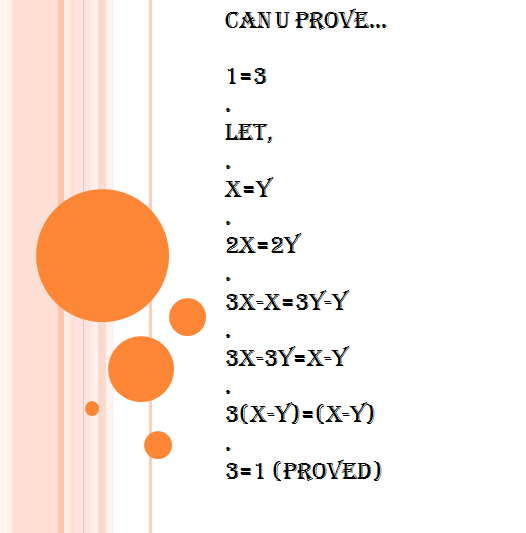1=3 right? Is this not correct?


Administrator • Jan 11, 2014
Member • Jan 11, 2014
Member • Jan 11, 2014
Right.Anoop KumarIt's actually 3*0 = 0
Member • Jan 12, 2014
Member • Jan 12, 2014
Administrator • Jan 12, 2014
Member • Jan 12, 2014
yesKaustubh KatdareThe first line itself is wrong. When you say, 'x=y', which means 'x' and 'y' are one and the same thing. So it can be extended to any level and prove anything equal to anything.
Member • Jan 14, 2014
Not really. X can be the number of girls in a class while y can be the number of desks in the class. The real issue is that division by zero is not a defined mathematical operation. The whole thing is set up as a confusing buzz, hiding the wrong operation.micheal johnyes
Member • Jan 17, 2014
Member • Sep 15, 2014
A.V.RamaniRight.
The last but one step can be elaborated as 3 x 0 = 1 x 0. The fallacy is that dividing both sides by zero gives 3 = 1.
Dividing by zero is an invalid operation.
Member • Sep 16, 2014
Member • Sep 16, 2014
Not really.shiwa436The above thing is just like.....
If a=b , b=c then a=c
Implies 2=root(4) , root(4)=-2 then 2=-2
Member • Sep 16, 2014
Administrator • Sep 16, 2014
Member • Sep 16, 2014
Sqrt(4) = +/- 2shiwa436#-Link-Snipped-# ramani.. Sir,
A small explanation will convince us, both the things are just outta incomplete application of actual rules....
Member • Sep 17, 2014
The problem is not the assumption. Mathematics gives us the full liberty to assume anything that fits the rules (and here assuming two variables are equal is not against any). The problem is the step (tricky step) which is so common to many such "proofs" which claim flabbergasting results to be true. This tricky step is intentionally introduced because it skips the attention of most amateur proof readers: and the step is called "division by zero", which is not defined.Kaustubh KatdareThis is the simplest explanation:
The 'proof' starts by assuming 'X' = 'Y'. Since X and Y aren't defined -> you should be able to prove almost anything; because it's based on 'assumption' that X = Y.
Member • Nov 26, 2014
below the 4th dotRajni JainWhere is the mistake in the below explanation?